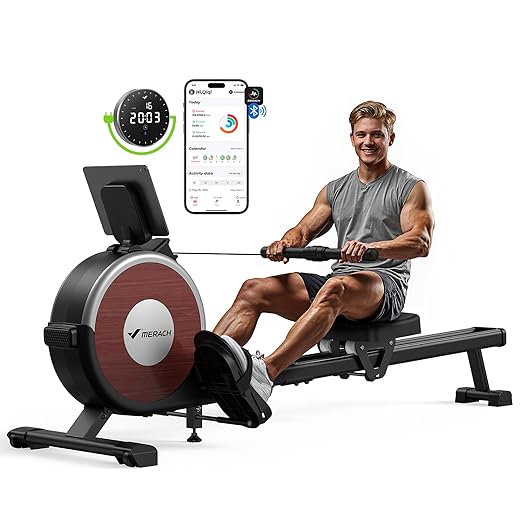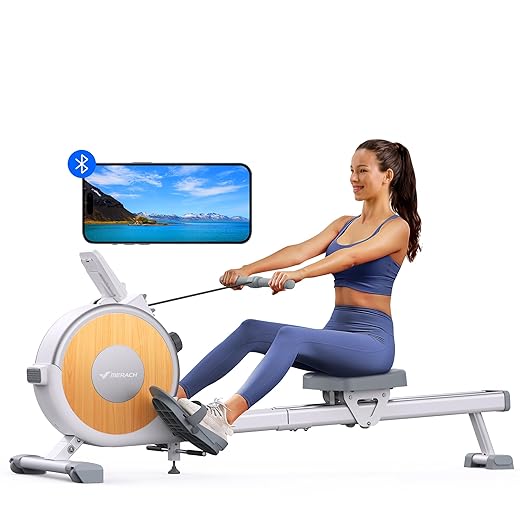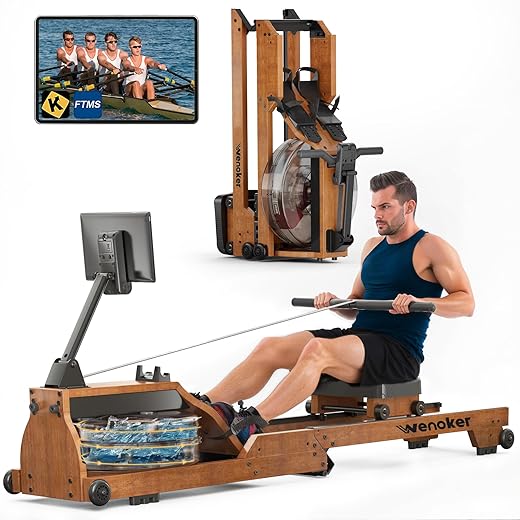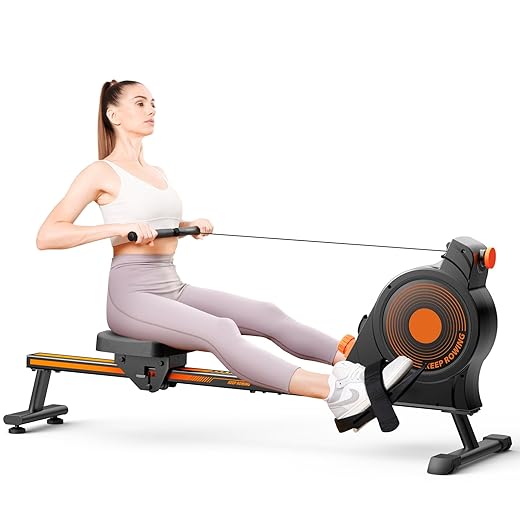Most people underestimate how effective rowing machines can be for a full-body workout that builds strength, endurance, and power all at once. Whether you’re just starting out or looking to level up your routine, these six rowing workouts are designed to help you improve your technique, increase your stamina, and boost your fitness safely and efficiently. By following these workouts, you’ll engage more muscles, protect your joints with low-impact exercise, and enjoy the mental and physical benefits that come with consistent rowing sessions.
Unlocking the Potential: The Transformative Benefits of Rowing Machine Workouts
How can rowing workouts transform your fitness and health?Rowing machines pack a unique punch by combining cardiovascular fitness with strength training, all while being gentle on your joints. You’re not just improving your heart health; you’re building a platform for total-body strength through consistent movement that activates both the upper and lower body. Over time, this dual approach helps you burn calories efficiently, supports weight management goals, and even enhances your mental resilience thanks to the rhythmic, meditative nature of rowing.
Incorporating rowing into your fitness regimen also adds variety to your workouts, which can help maintain motivation and prevent plateaus. Whether you opt for longer endurance sessions or brief, intense intervals, the rowing machine’s adaptability makes it perfect for all fitness levels and age groups, enabling you to tailor workouts that challenge you and drive meaningful progress without the wear and tear that high-impact exercises might cause.
Full-Body Engagement: More Than Just a Cardio Session
Rowing uniquely engages approximately 86% of your muscles with every stroke, making it much more than a simple cardio workout. Your legs do the heavy lifting during the drive phase, pushing powerfully against the footplates, while your core works hard to stabilize your body and transfer that force through your torso. Your back, shoulders, and arms then pull the handle, completing the sequence and maintaining fluidity in your movement.
This full-body involvement means you’re building muscle and endurance simultaneously. Unlike machines that isolate parts of the body, rowing requires smooth coordination of multiple muscle groups, promoting functional fitness that transfers well to everyday activities. As a low-impact exercise, it also gives your joints a break while still providing a serious strength and aerobic boost.
Building Endurance and Power: Why Rowing Works
The blend of steady-state and interval training available on a rowing machine lets you develop both endurance and explosive power. Endurance rows improve your cardiovascular capacity and muscular stamina, allowing you to sustain effort over longer periods—whether that’s a 30-minute steady pace or a 45-minute endurance workout. Pushing your stroke rate while maintaining form builds aerobic efficiency, helping your heart and lungs work smarter and harder.
Meanwhile, focusing on power drives—slow, deliberate strokes at lower stroke rates—trains your muscles to generate maximum force, creating strength gains often overlooked in typical cardio workouts. By spending more time under tension with each stroke, you boost muscular endurance and recruit fiber types associated with power, giving you more punch in every movement both on and off the machine.
Whether you tackle interval sprints or long-distance rows, the rowing machine challenges your energy systems in a way that few other workouts do. The varied pacing forces your body to adapt, improving your VO2 max and lactate threshold, which translates into better performance across multiple sports and daily activities.
Dive into Action: 6 Rowing Machine Workouts to Challenge Yourself
Ready to push your limits with dynamic rowing routines?Rowing workouts come in many forms, each designed to push different aspects of your fitness. Whether you’re working on mastering the basics, boosting endurance, or building raw power, the variety keeps you engaged and progressing. Mixing up your sessions also helps prevent plateaus and keeps training enjoyable, which means you’ll be more likely to stick with it and see results.
This selection of six rowing workouts offers options for all fitness levels and goals. From beginner-friendly sessions to high-intensity challenges, these routines are crafted to make you stronger, fitter, and more confident on the rower with every stroke.
1. Your First Stroke: The Beginner Rowing Workout
Starting out with rowing means getting comfortable with the rhythm and technique. A solid beginner workout focuses on pacing yourself and learning what stroke rate feels sustainable. For instance, five minutes of easy warm-up rowing at around 16–20 strokes per minute helps awaken your muscles and joints, setting you up for a smooth transition into the main workout.
The actual workout alternates between 1-minute intervals of easy and moderate intensity, with stroke rates ranging from 16 to 24. This variation introduces you to managing effort without rushing the technique. Taking recovery moments to row leisurely or pause briefly allows your body to reset, making this session approachable yet effective in building a foundational skillset.
2. The Power of Intervals: An Interval Rowing Workout
Interval training on the rowing machine amps up your cardiovascular fitness quickly by alternating bursts of effort with recovery. For example, a 20-minute routine might start with a warm-up combining easy and moderate efforts, gradually waking your muscles. Then, moving into intervals such as three minutes at a moderate-to-high stroke rate (24–28) followed by a minute of challenging pace pushes your anaerobic capacity, while built-in recoveries let you catch your breath and maintain quality strokes.
This format not only improves your cardiovascular system but also strengthens your muscles by simulating the varying demands of real-life situations, like quick sprints or climbing hills. The mix of effort intensities keeps your body guessing, optimizing calorie burn and fitness gains.
Intervals are powerful because they stimulate both your aerobic and anaerobic systems, making them one of the most efficient ways to boost overall endurance and speed in a short time frame.
3. Distance Challenges: The Ultimate Distance Rowing Workout
Setting a distance goal transforms rowing into a focused endurance challenge. Tackling 2,000 meters, for example, pushes you to pace yourself steadily at a higher stroke rate, typically between 26 and 32. This workout teaches consistency and mental toughness as you seek to maintain a solid pace over several minutes, helping build cardiovascular stamina and muscular resilience.
By noting your completion time, you create a benchmark for progress. Over weeks of training, aiming to beat your previous distance time adds a motivating competitive element, turning every session into an opportunity for improvement.
Distance workouts sharpen your ability to sustain power output, making activities like running or cycling feel easier by training your heart, lungs, and muscles to work efficiently.
4. Endurance Excellence: Mastering the Endurance Rowing Workout
Extended rowing sessions of 30 minutes or more are designed to enhance aerobic capacity and muscular endurance. The example 45-minute workout blends steady efforts with intervals that cycle through easy and moderate intensities, with stroke rates in the 18–28 range. This balancing act challenges your stamina without overwhelming fatigue, helping you acclimate to sustaining exercise for longer durations.
Repeating sets with short recoveries mimics the pacing strategies used in distance sports, training your body to manage energy and delay fatigue. Over time, these endurance rows develop a robust cardiovascular base that supports improved performance across all other workout types and everyday activities.
Endurance rowing not only boosts your physical stamina but also helps hone mental focus and steady breathing, crucial for prolonged physical effort.
5. High-Intensity Fun: Exploring the Tabata Rowing Workout
Tabata rowing pushes you into bursts of maximum effort that last just 20 seconds, followed by brief 10-second rests. This pattern repeats over multiple cycles, creating a high-intensity, metabolically demanding workout that can be completed in as little as four minutes for a quick challenge or extended into longer sessions by adding repeats. The quick transitions between max push and rest force your recovery systems to accelerate, improving your fitness rapidly.
Incorporating Tabata intervals into your routine helps enhance your power output, VO2 max, and lactic acid tolerance—all markers of elite fitness. Because of its intensity, this workout stands out as a powerful tool for those looking to burn fat efficiently and build explosive strength.
Tabata workouts are especially effective because they maximize effort in minimum time, delivering outstanding fitness benefits even when your schedule is tight.
6. Power Yourself Up: The Power Drive Rowing Workout
Slowing down your stroke rate to between 20–23 allows you to focus on the quality and force of every pull. This workout hones in on strength by encouraging powerful, controlled drives rather than fast, choppy strokes. Longer time under tension during each stroke increases muscular engagement, hitting the legs, core, and back with more intensity than typical high-tempo rowing.
Power drive workouts help refine your technique by demanding full-body coordination and precision. Rather than racing against the clock, you focus on moving with purpose and control, building raw power that translates into better efficiency and speed during faster sessions.
By emphasizing strength over speed, power drive rowing improves your overall rowing economy and reduces injury risk through better form and muscle balance.
What to Expect: Navigating the Rowing Class Experience
Curious about what really happens in a rowing class?Stepping into a rowing class often feels like joining a tight-knit community of rowers all pushing toward similar fitness goals. Classes vary widely—some emphasize endurance, others power or technique—but every session blends cardio with strength in a low-impact setting. Your instructor will guide you through warm-ups, drills, and intervals, tailoring cues to help you dial in form and pacing. Because rowing engages up to 86% of your muscles, these classes demand both focus on technique and stamina, leaving you feeling worked but energized. Expect music or timed intervals to keep cadence and motivation high, often paired with real-time metrics like stroke rate and split time shown on monitors.
Depending on the studio or gym, you might find single-rower classes where everyone rows simultaneously on individual machines, or you could join larger rowing studio setups that mimic on-water boats—encouraging teamwork and rhythm. While the motion is low-impact, maintaining good posture is key to avoiding strain, and many classes emphasize this through continuous instructor feedback. No matter your level, the combination of cardio and strength training wrapped into an efficient, full-body workout makes every class worthwhile.
Classroom Dynamics: Engaging with Instructors and Peers
Rowing instructors bring motivation and expertise that elevate the class experience beyond just moving through strokes. Their real-time corrections help you refine your technique, pushing your power output without sacrificing form. Instructors often break down the session into clear phases—warm-up, main intervals, cool down—allowing you to mentally prepare and track progress throughout the workout. Some lead with verbal cues focusing on leg drive or core engagement, while others incorporate visual demonstrations or even mirrors to enhance learning. This kind of focused coaching pushes your row to the next level, especially as you start to understand the nuances behind stroke rate and power per pull.
Engaging with peers adds a social dynamic that can boost motivation and adherence to your fitness goals. Group classes often foster a sense of camaraderie—you’ll hear encouragement as others hit their intervals or struggle through those final challenging seconds. Some studios even host friendly competitions based on distance or watts output, injecting a fun and motivating challenge. Whether you’re racing against your own best times or side-by-side with gym buddies, that shared energy often sparks a drive to push a little harder than you might on your own.
The Gear and Setup: Making the Most of Your Rowing Class
Modern rowing machines vary but typically feature adjustable foot straps, a comfortable sliding seat, and performance monitors displaying stroke rate, split time, and calories burned. Getting the setup right before your class starts sets the tone for an effective session. You’ll want to adjust the foot straps snugly around your shoes—too loose means wasted energy as your feet slip, too tight can cause discomfort. Seat positioning usually requires no adjustment, but finding your optimal smooth slide can make a huge difference during longer workouts. Before the class kicks off, take a couple of practice strokes focusing on proper form while checking that your machine’s drag factor (resistance setting) feels suited to your fitness level. If you’re unsure, instructors will often recommend drag levels ranging from 110 to 130 for most workouts, balancing resistance with stroke speed.
Many rowing machines also allow you to customize the drag and resistance, which plays a crucial role in adapting intensity to your personal goals—higher drag mimics the feeling of rowing a heavy boat and builds strength, while lower drag favors speed and endurance. Wearing moisture-wicking, fitted clothing helps prevent chafing during the sliding motion, and investing in rowing gloves or grip aids can minimize blisters on longer sessions. Hydration stations near the machines or a water bottle handy is a must; keeping your fluid levels up ensures performance doesn’t dip, especially during interval or power drive workouts.
Additional accessories like heart rate monitors or fitness trackers sync smoothly with many rowing machines, allowing you to analyze your output post-class and track improvements. Some studios offer rower-specific mats to dampen noise and protect flooring, making your workout more enjoyable, particularly in at-home setups. Combining these gear considerations with focused instruction and your chosen workout style equips you to get the most bang for your buck out of every rowing class.
Rowing Time: How to Optimize Your Workout Duration
How long should you row for the best results?Choosing the right duration for your rowing workouts can make a significant difference in how effectively you build strength, endurance, and power. Shorter sessions, like 10 to 20 minutes, are excellent for high-intensity interval training or power-focused workouts, giving you a serious calorie burn and muscle engagement in minimal time. Conversely, longer sessions—ranging from 30 to 60 minutes—help develop aerobic capacity and stamina, allowing you to maintain a steady effort that challenges your cardiovascular system without overwhelming your muscles or joints.
Keep in mind that how long you row should align with both your current fitness level and your workout goals. For example, a beginner might find 15 minutes of mixed-effort rowing enough to build a solid foundation, while seasoned athletes often benefit from moderately longer sessions that incorporate varied intensity zones to avoid plateaus and keep progress steady. Listening to your body’s signals during the workout can help you decide when to push harder or ease back for recovery, ensuring that your sessions stay productive yet sustainable.
Finding Your Ideal Length: The Science of Effective Workouts
Research consistently shows that workouts of at least 20 minutes offer physiological benefits like improved VO2 max and muscular endurance, but efficiency peaks when you balance intensity with duration. For instance, studies on cardio machines reveal that rowing for about 20 to 30 minutes at a moderate pace can optimize fat burning while also enhancing cardiovascular fitness. Meanwhile, very short bursts under 10 minutes often prioritize power and anaerobic capacity but may not provide enough aerobic stimulus for endurance gains.
Another factor is recovery and adaptation. Workouts closer to an hour allow for sustained calorie expenditure and muscular engagement but can increase fatigue and recovery needs, especially if done daily. For efficient progress, splitting your rowing time into focused intervals within a session—say four 5-minute blocks with short rests—can deliver multiple benefits without pushing your system into overtraining. If maintaining a routine is your goal, sessions in the 20-to-30-minute range tend to have high adherence levels due to their balance of challenge and manageability.
Balancing Intensity with Duration: Crafting Your Routine
Combining how hard you row with how long you row yields the best returns. For example, a high-intensity interval workout lasting 15 to 20 minutes can trigger impressive cardiovascular and muscular gains because the short duration allows you to push near maximal effort. On the flip side, longer steady-state rows at a controlled pace—lasting 30 to 45 minutes—build aerobic endurance and mental fortitude through sustained effort without the severe fatigue spikes that come with HIIT.
Programming your sessions around this balance can mean alternating days of intense, shorter rows with longer, lower-intensity sessions. A weekly routine that includes one or two interval sessions mixed with endurance-focused rows often improves overall fitness more effectively than sticking to a single style or duration. This method also reduces injury risk by varying the strain placed on your muscles and joints.
Diving deeper into your rowing routine’s structure offers opportunities to tailor it precisely to your needs. Using metrics like stroke rate, split time, and perceived exertion can guide you in modulating effort so you stay within your target zones, whether you’re aiming for power, endurance, or recovery. Experimenting with durations—from quick 10-minute power bursts to relaxed 40-minute steady rows—helps you discover what feels most effective and enjoyable, setting the stage for consistent progress.
Finding Your Rhythm: How Often Should You Hit the Rowing Machine?
What’s the ideal weekly frequency for effective rowing workouts?Consistency is key when it comes to reaping the full benefits of rowing. Most fitness experts recommend starting with about 3 to 4 sessions per week, especially if you’re new to the machine. This frequency gives your muscles time to recover while steadily building your cardiovascular endurance and strength. For those already active with other forms of exercise, integrating rowing 2–3 times weekly can serve as an efficient cross-training method without overloading your routine.
As you progress, your rowing frequency might naturally increase to match your goals—be it endurance, power, or skill development. Some seasoned rowers gear up for 5–6 sessions per week, but maintaining form and avoiding burnout becomes increasingly important at this level. Balancing rowing workouts with rest days and complementary strength training helps preserve your performance and overall health.
Building Consistency: Establishing Your Rowing Schedule
Setting a regular rowing schedule creates structure, making it easier to stick with the habit. A smart way to start is by slotting shorter sessions—perhaps 15 to 20 minutes—on weekdays, reserving longer or more intense rowing efforts for weekends or alternate days. For example, a Monday, Wednesday, Friday pattern allows recovery days to sneak in between to help your body adjust and grow stronger.
Incorporate rowing sessions around your lifestyle commitments by keeping flexibility in mind. If morning workouts feel rushed, try midday or evening sessions. Using a mix of different rowing workouts from the interval, endurance, and power drive options keeps variety high and motivation intact. Over time, you’ll find a rhythm that matches your energy levels and fitness goals, helping rowing become a reliable and enjoyable part of your routine.
Listening to Your Body: Signs to Adjust Your Frequency
Noticing persistent fatigue, joint discomfort, or declining performance signals that it might be time to dial back your rowing frequency. Muscle soreness that lasts more than a couple of days or nagging aches—especially in your lower back or shoulders—point to the need for additional recovery. Overtraining can sneak up on you, so pay attention to these subtle signs before injuries take hold.
If you spot these warning signs, scaling back to 2 or even just 1 rowing session per week temporarily can help you reset. Focus on active recovery, gentle stretching, or complementary low-impact exercises like swimming or yoga. Adjusting frequency isn’t a setback; it’s a strategic step to keep rowing sustainable long term.
On the flip side, if you find yourself bouncing back quickly after workouts and feeling stronger session by session, that’s a green light to gradually increase your frequency. Consistent feedback from your body—as well as tracking improvements in stroke rate, endurance, or recovery time—will guide you toward an optimal training schedule without risking burnout or injury.
Conclusion
Taking this into account, incorporating these six rowing machine workouts into your routine can be a game-changer for building your skills, endurance, and power. Whether you’re just starting out with the beginner workout or challenging yourself with the power drive and Tabata sessions, there’s something here to meet your fitness needs and keep things fresh. You’ll find that as your technique improves, so will your confidence and overall performance on the machine.
By mixing different workout styles—from steady endurance rows to high-intensity intervals—you’ll keep your body guessing and avoid workout boredom, making it easier to stay motivated and consistent. Plus, with a focus on both strength and endurance, you’re setting yourself up for balanced fitness progress that goes beyond just rowing. So hop on, give these workouts a try, and enjoy the strong, energized version of yourself that comes with regular rowing practice.
FAQ
For consistent progress, aim to include rowing workouts 3 to 4 times per week. This frequency allows your body to recover while building cardiovascular endurance and muscular strength progressively. Mixing different workout types, such as interval and endurance sessions, can help maximize overall fitness gains.
Start by focusing on the fundamental rowing form—drive with your legs first, then lean your torso back, and finally pull with your arms. Practicing at a slow and controlled stroke rate during easy-effort sessions helps develop proper mechanics. Watching instructional videos or working with a coach can also provide feedback and accelerate skill improvement.
Yes, combining rowing workouts with strength training enhances power development. Power drive rowing workouts that emphasize slow, strong strokes complement resistance exercises targeting major muscle groups. This combination increases muscle recruitment and overall force output during rowing strokes.
Interval rowing workouts, which alternate between high-intensity bursts and recovery periods, challenge your cardiovascular system to adapt to varying intensities. This helps improve your heart rate recovery and overall cardiovascular capacity faster than steady-state rowing, where effort remains consistent throughout the session.
When setting distance goals, such as 2,000-meter sprints, focus on maintaining consistent stroke rate and pacing throughout the workout. Monitoring your finish times over weeks tracks progress and provides motivation. It’s important to warm up properly and cool down afterward to prevent injury and promote recovery.





















